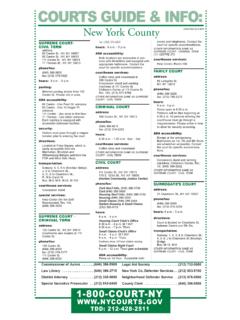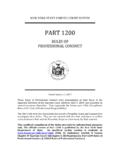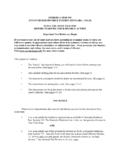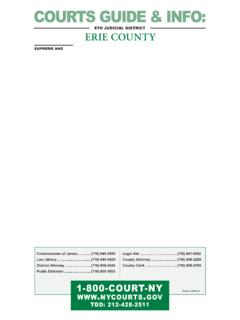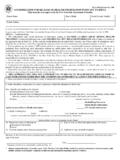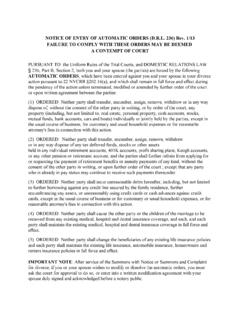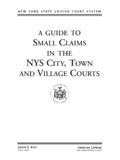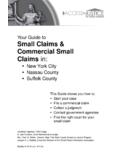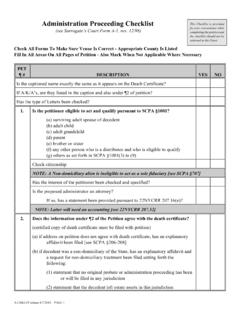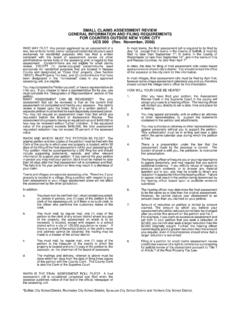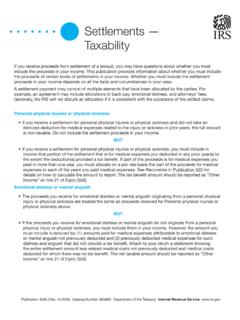Transcription of RULE 1 - Judiciary of New York
1 NEW york STATE UNIFIED COURT SYSTEMPART 1200 RULES OFPROFESSIONAL CONDUCTD ated: January 1, 2017 These Rules of Professional Conduct were promulgated as Joint Rules of theAppellate Divisions of the Supreme Court, effective April 1, 2009, and amended onseveral occasions thereafter. They supersede the former part 1200 (DisciplinaryRules of the Code of Professional Responsibility).The New york State Bar Association has issued a Preamble, Scope and Comments toaccompany these Rules. They are not enacted with this Part, and where a conflictexists between a Rule and the Preamble, Scope or a Comment, the Rule unofficial compilation of the Rules provided for informational purposesonly.
2 The official version of Part 1200 is published by the New york StateDepartment of State. An unofficial on-line version is available (Title 22 [ Judiciary ]; Subtitle B Courts;Chapter IV Supreme Court; Subchapter E All Departments; Part 1200 Rules ofProfessional Conduct; Rules of Professional Conduct).TABLE OF CONTENTS PageRULE of Representation and Allocation of Authority Between Client and and Division of of of Interest: Current Clients: Specific Conflict of Interest to Former of Conflicts of Conflicts of Interest for Former and CurrentGovernment Officers and Conflicts of Interest for Former Judges,Arbitrators, Mediators or Other Third-Party As With Diminished Identity of Funds and Property of Others; Fiduciary Responsibility; Commingling and Misappropriation of Client Funds or Property.
3 Maintenance of Bank Accounts; Record Keeping; Examination of or Terminating PageRULE of Law to Prospective for Use by Third Serving as Third-Party Claims and of Before a to Opposing Party and and Preserving the Impartiality of Tribunals and As Responsibilities of Prosecutorsand Other Government In Non-Adjudicative In Statements To With Person Represented By With Unrepresented for Rights of Third PageRULE After Incidents Involving personal injury or Wrongful of Law Firms, Partners, Managers and Supervisory of a Subordinate s Responsibility for Conduct of Independence of a Practice of On Right To Regarding Nonlegal Relationship Between Lawyers and Nonlegal Pro Bono in a Legal Services Reform Activities Affecting Client in Limited Pro Bono Legal Service for and Recommendation of Professional of Practice and Notices, Letterheads and PageRULE in the Bar Admission Officers and Professional Authority and Choice of 1200 - RULES OF PROFESSIONAL CONDUCTRULE (a)
4 Advertisement means any public or private communication made byor on behalf of a lawyer or law firm about that lawyer or law firm s services, theprimary purpose of which is for the retention of the lawyer or law firm. It does notinclude communications to existing clients or other lawyers.(b) Belief or believes denotes that the person involved actuallybelieves the fact in question to be true. A person s belief may be inferred fromcircumstances.(c) Computer-accessed communication means any communicationmade by or on behalf of a lawyer or law firm that is disseminated through the use ofa computer or related electronic device, including, but not limited to, web sites,weblogs, search engines, electronic mail, banner advertisements, pop-up and pop-under advertisements, chat rooms, list servers, instant messaging, or other internetpresences, and any attachments or links related thereto.
5 (d) Confidential information is defined in Rule (e) Confirmed in writing denotes (i) a writing from the person to thelawyer confirming that the person has given consent, (ii) a writing that the lawyerpromptly transmits to the person confirming the person s oral consent, or (iii) astatement by the person made on the record of any proceeding before a tribunal. Ifit is not feasible to obtain or transmit the writing at the time the person gives oralconsent, then the lawyer must obtain or transmit it within a reasonable timethereafter.(f) Differing interests include every interest that will adversely affecteither the judgment or the loyalty of a lawyer to a client, whether it be a conflicting,inconsistent, diverse, or other interest.
6 (g) Domestic relations matter denotes representation of a client in aclaim, action or proceeding, or preliminary to the filing of a claim, action orproceeding, in either Supreme Court or Family Court, or in any court of appellatejurisdiction, for divorce, separation, annulment, custody, visitation, maintenance,child support or alimony, or to enforce or modify a judgment or order in connectionwith any such claim, action or proceeding.(h) Firm or law firm includes, but is not limited to, a lawyer or lawyersin a law partnership, professional corporation, sole proprietorship or otherassociation authorized to practice law; or lawyers employed in a qualified legalassistance organization, a government law office, or the legal department of acorporation or other organization.
7 (I) Fraud or fraudulent denotes conduct that is fraudulent under thesubstantive or procedural law of the applicable jurisdiction or has a purpose todeceive, provided that it does not include conduct that, although characterized asfraudulent by statute or administrative rule, lacks an element of scienter, deceit,intent to mislead, or knowing failure to correct misrepresentations that can bereasonably expected to induce detrimental reliance by another.(j) Informed consent denotes the agreement by a person to a proposedcourse of conduct after the lawyer has communicated information adequate for theperson to make an informed decision, and after the lawyer has adequately explainedto the person the material risks of the proposed course of conduct and reasonablyavailable alternatives.
8 (k) Knowingly, known, know, or knows denotes actualknowledge of the fact in question. A person s knowledge may be inferred fromcircumstances.(l) Matter includes any litigation, judicial or administrative proceeding,case, claim, application, request for a ruling or other determination, contract,controversy, investigation, charge, accusation, arrest, negotiation, arbitration,mediation or any other representation involving a specific party or parties.(m) Partner denotes a member of a partnership, a shareholder in a lawfirm organized as a professional legal corporation or a member of an associationauthorized to practice law.
9 (n) Person includes an individual, a corporation, an association, a trust, apartnership, and any other organization or entity.(o) Professional legal corporation means a corporation, or anassociation treated as a corporation, authorized by law to practice law for profit.(p) Qualified legal assistance organization means an office ororganization of one of the four types listed in Rule (b)(1)-(4) that meets all of therequirements thereof.(q) Reasonable or reasonably, when used in relation to conduct by alawyer, denotes the conduct of a reasonably prudent and competent lawyer.
10 Whenused in the context of conflict of interest determinations, reasonable lawyer denotes a lawyer acting from the perspective of a reasonably prudent and-2-competent lawyer who is personally disinterested in commencing or continuing therepresentation.(r) Reasonable belief or reasonably believes, when used inreference to a lawyer, denotes that the lawyer believes the matter in question andthat the circumstances are such that the belief is reasonable.(s) Reasonably should know, when used in reference to a lawyer,denotes that a lawyer of reasonable prudence and competence would ascertain thematter in question.
